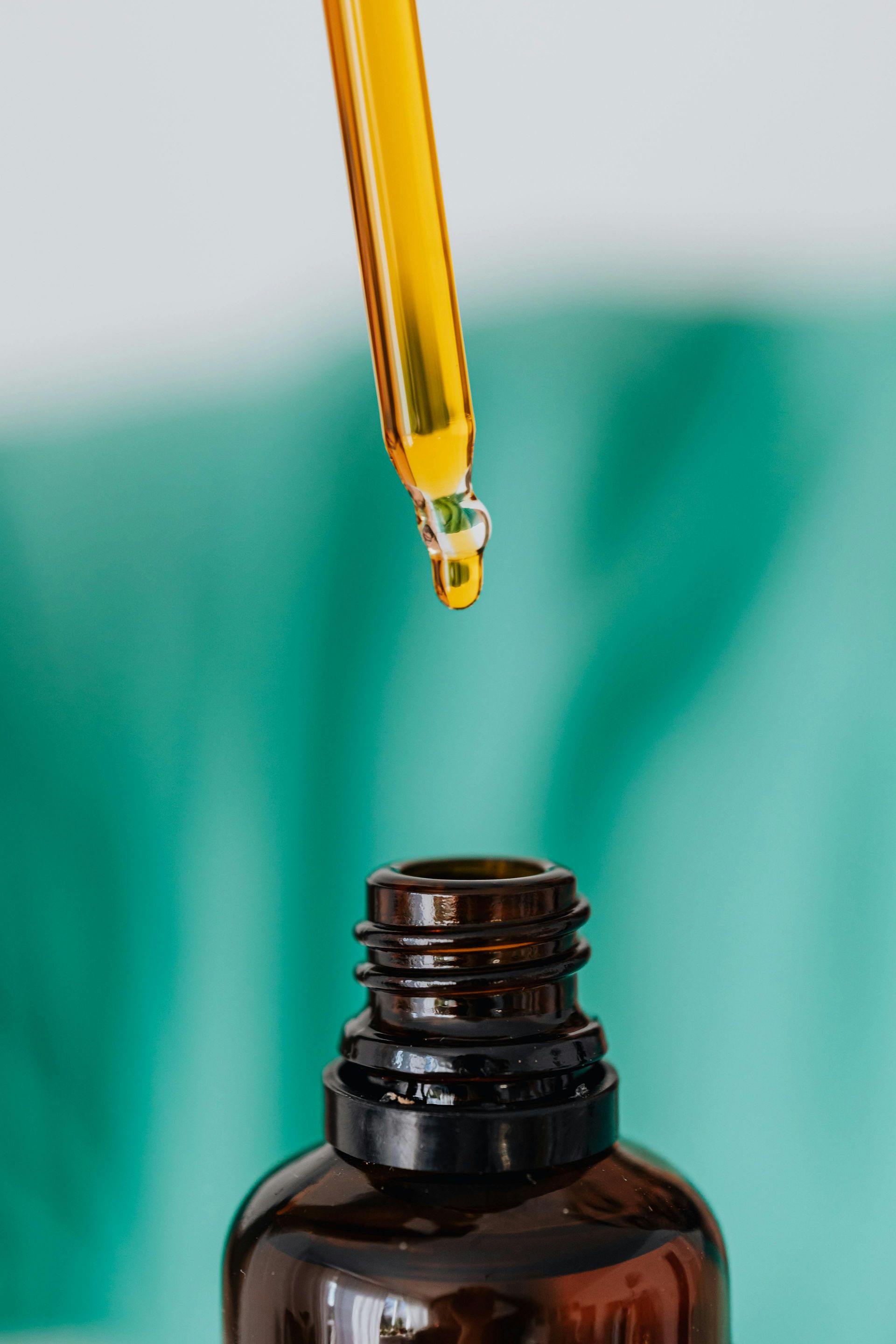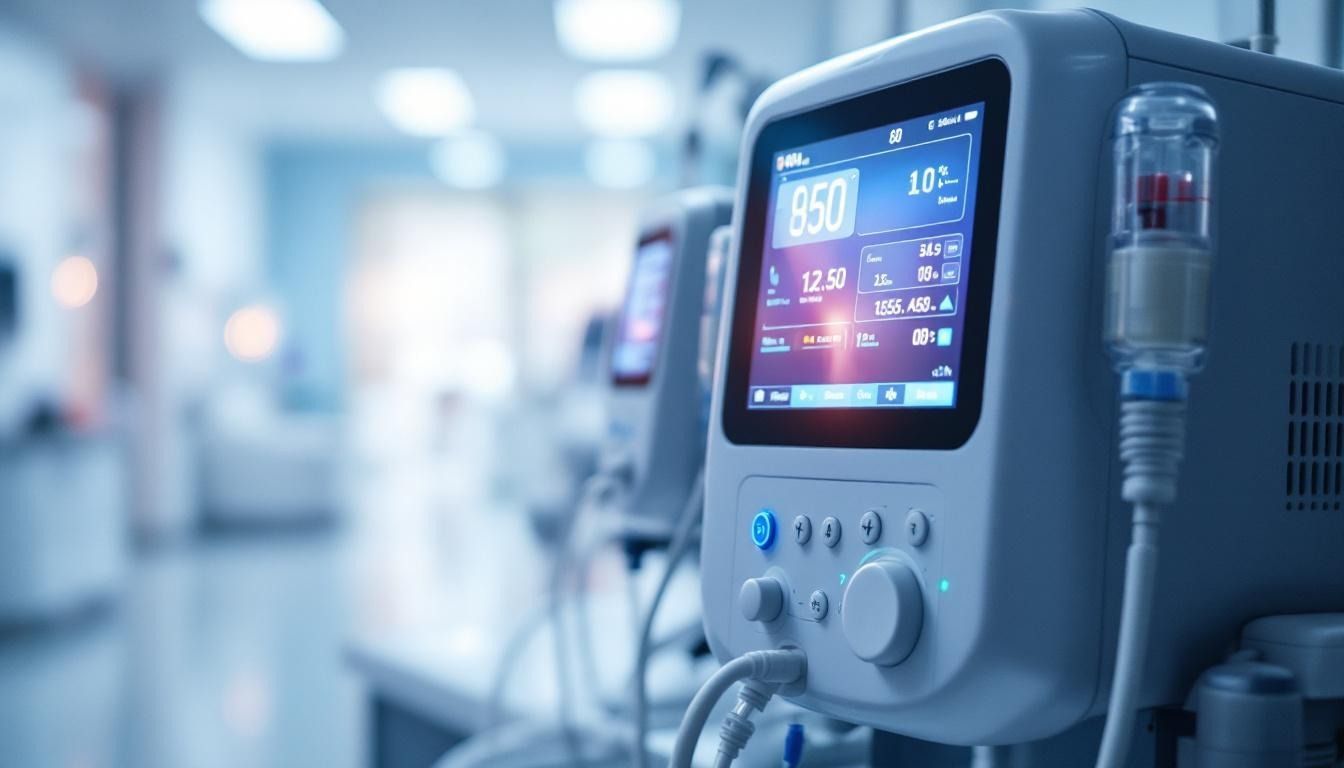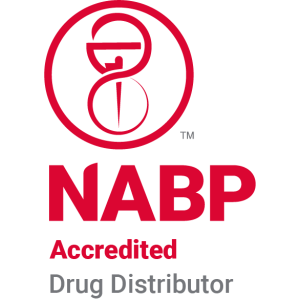Understanding the Role of Carbohydrates in TPN Formulations
Unraveling the Complex Role of Carbohydrates in TPN
Total parenteral nutrition (TPN) stands as a cornerstone in managing malnutrition for patients unable to utilize or tolerate enteral feeding. Among its core components, carbohydrates, principally in the form of glucose, serve as the primary energy source. This article delves into the multifaceted role of carbohydrates in TPN formulations, exploring their metabolic pathways, formulation strategies, clinical implications, and their impact on patient outcomes.
Fundamental Role and Purpose of Carbohydrates in TPN

What is the fundamental role of carbohydrates in total parenteral nutrition (TPN)?
Carbohydrates are a vital component of total parenteral nutrition (TPN), primarily supplied as glucose. They serve as the main energy source, fueling cellular processes and supporting vital metabolic functions such as brain activity, muscle performance, and organ function. In TPN formulations, carbohydrates typically provide around 60% of the non-protein calories, making them crucial for maintaining overall energy balance.
The primary carbohydrate used in TPN is dextrose, which is available in concentrations from 5% to 70%. The standard practice aims to supply enough glucose to meet the body's energy demands without causing metabolic disturbances. The glucose infusion rate is carefully controlled, usually maintained below 5 mg/kg/min to prevent hyperglycemia, hypertriglyceridemia, and fatty liver. Proper management entails close monitoring of blood glucose levels, typically aiming for a range of 80–110 mg/dL, with an upper threshold of <145 mg/dL to reduce morbidity and mortality.
In addition to providing energy, carbohydrates support key aspects of metabolic health, including the synthesis of nucleic acids and other vital biomolecules. They also play a role in preventing hypoglycemia, especially after discontinuing TPN, by ensuring a steady supply of glucose during nutritional transition.
Therefore, in TPN, carbohydrates are indispensable for sustaining life, supporting organ function, and promoting recovery, but they require precise dosing and vigilant monitoring to avoid complications. Adjustments to carbohydrate content are made based on individual patient needs, health status, and risk factors such as critical illness or pre-existing diabetes.
Supporting Vital Functions and Meeting Caloric Needs
Carbohydrates provide the energy needed for basic cellular functions and are especially important for the central nervous system, which relies almost exclusively on glucose for energy. This makes the inclusion of glucose in TPN formulations essential for brain health and cognitive function.
Preventing Hypoglycemia After TPN Discontinuation
Gradual weaning from TPN is recommended to prevent hypoglycemia, a condition that can occur if glucose supply abruptly stops before the body's endogenous production and utilization mechanisms recover. Proper tapering helps stabilize blood glucose levels and supports the body's adaptation to oral or enteral nutrition.
In summary, carbohydrates in TPN fulfill a fundamental role in providing energy, supporting metabolic functions, and ensuring safe nutritional transitions, underscoring their critical place in overall nutritional therapy.
Types of Carbohydrates Used in TPN, such as Dextrose
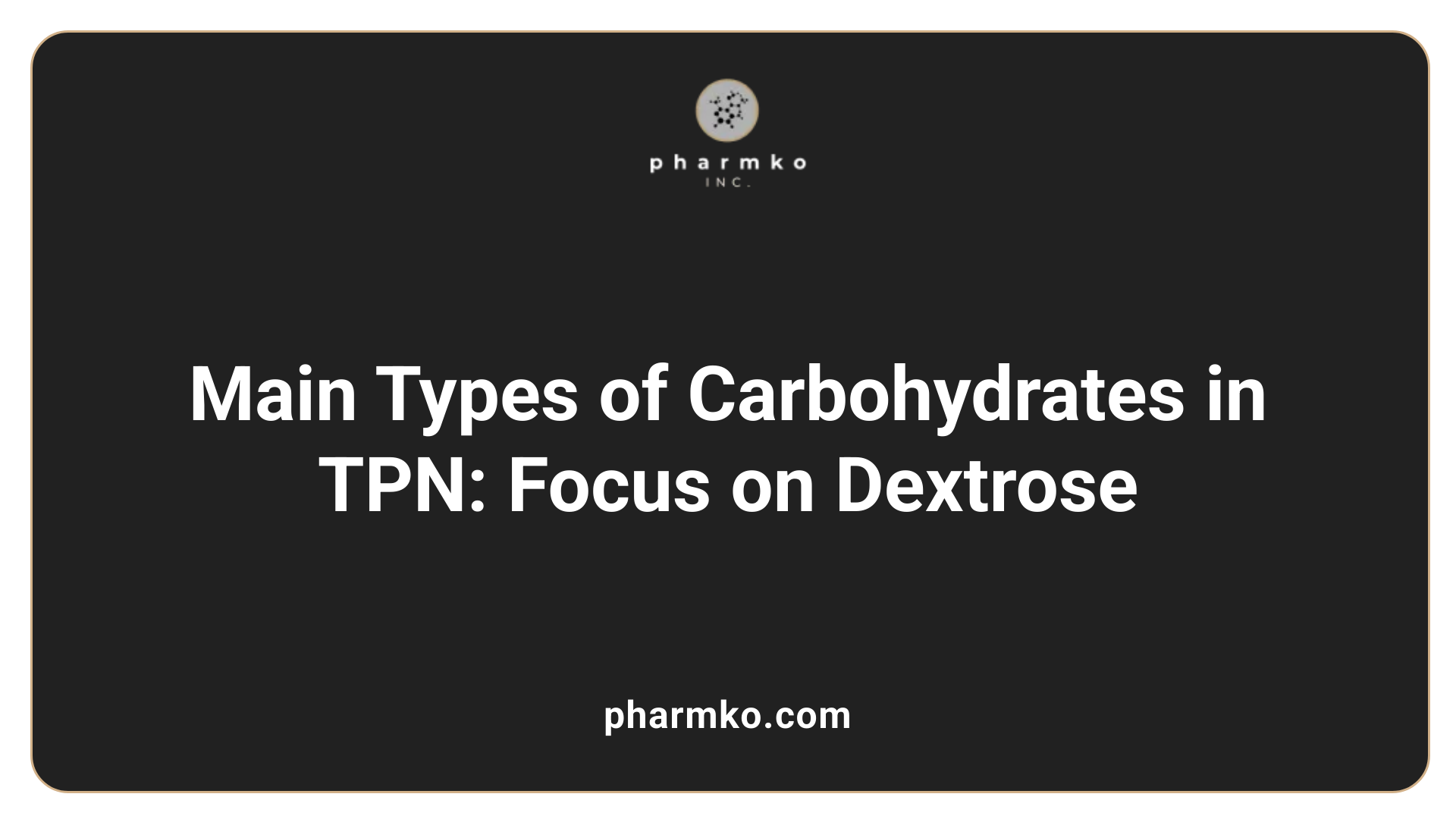
What types of carbohydrates are used in TPN solutions?
In total parenteral nutrition (TPN) solutions, the predominant carbohydrate source is glucose, mainly administered as dextrose. This form of sugar is favored because of its high solubility, availability, and metabolic compatibility with human physiology.
Dextrose, specifically dextrose monohydrate, is typically infused at concentrations ranging from 5% up to 70%, with most TPN formulations containing around 40%, 50%, or 70%. The goal is to provide approximately 60% of non-protein energy through glucose, generally amounting to about 3.0–3.5 g/kg of body weight per day.
Other carbohydrate options, such as xylite (a sugar alcohol) and fructose, are either discouraged or not recommended for use in TPN. Xylite is controversial due to limited data on safety and efficacy, and fructose should be avoided because it can lead to metabolic disturbances when administered parenterally.
Managing carbohydrate intake precisely is crucial, as excess carbohydrates can cause complications like hyperglycemia and hypertriglyceridemia. The glucose infusion rate is carefully maintained below 5 mg/kg/min to prevent metabolic disturbances, and blood glucose levels are closely monitored, aiming to stay within 80–110 mg/dL.
In summary, glucose in the form of dextrose remains the primary carbohydrate used in TPN solutions, with concentrations tailored to the patient's needs and cardiovascular stability.
Metabolism and Physiological Significance of Carbohydrates in TPN
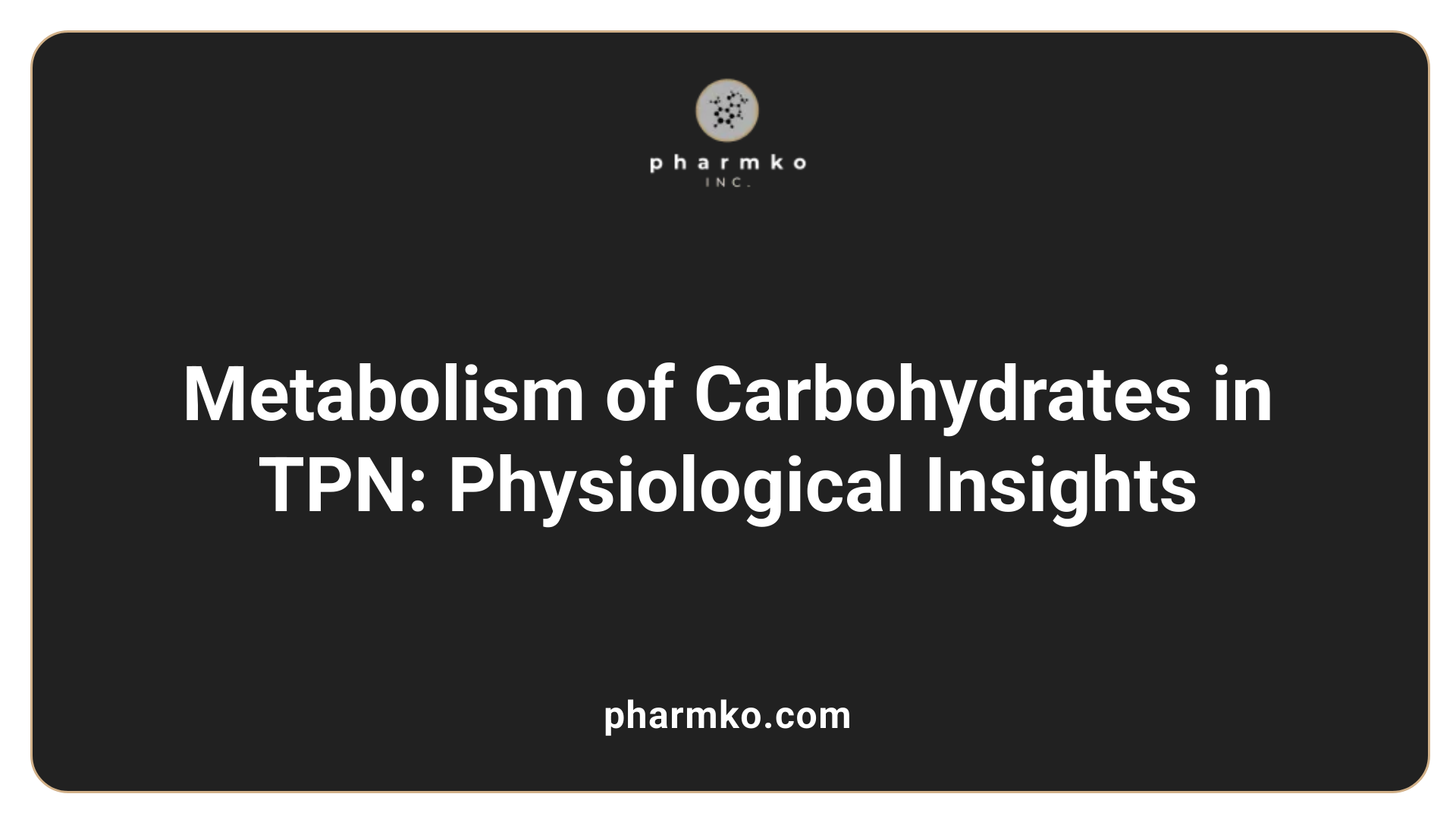
How are carbohydrates metabolized in TPN and what is their physiological significance?
Carbohydrates in total parenteral nutrition (TPN) are mainly supplied as dextrose, which quickly undergoes metabolic processes to generate energy essential for cellular and bodily functions. When administered intravenously, dextrose bypasses the digestive system and enters the bloodstream directly, where it is rapidly absorbed.
Once in circulation, glucose is taken up by tissues such as muscle, fat, and the brain, where it undergoes glycolysis—an enzymatic pathway converting glucose into energy in the form of ATP. This process is vital for maintaining basic physiological processes, including nerve function, muscle activity, and cellular repair.
The primary role of carbohydrates in TPN is to provide a significant portion of non-protein calories—typically around 60%—which supports overall energy needs without overtaxing the patient's metabolic capacity. Ideally, approximately 3.0–3.5 grams of glucose per kilogram of body weight should be infused daily.
However, the rapid metabolism of glucose within TPN depends on the patient's ability to oxidize it efficiently. Excessive carbohydrate infusion can overwhelm this capacity, leading to metabolic disturbances such as hyperglycemia (high blood sugar levels), hypertriglyceridemia, and fatty liver.
Glucose oxidation rate limits
The maximum rate at which glucose can be oxidized in the human body is generally accepted to be between 5 to 7 mg/kg/min. Infusing glucose above this rate can result in accumulation of unmetabolized glucose, contributing to adverse effects including hyperglycemia and hepatic steatosis. Therefore, maintaining glucose infusion rates below 5 mg/kg/min is standard practice to minimize complications.
Patients at high risk for glucose intolerance, such as those with diabetes, sepsis, critically ill states, or on steroid therapy, require even more conservative carbohydrate infusion rates—often starting at 1–2 g/kg/day. Monitoring blood glucose levels closely is essential, aiming to keep levels between 80–110 mg/dL to optimize patient outcomes.
Impacts on insulin sensitivity and metabolic health
The metabolism of glucose in TPN influences insulin sensitivity significantly. Hyperglycemia, resulting from excessive carbohydrate infusion, can impair insulin action, leading to insulin resistance. This condition complicates blood sugar management and may increase morbidity.
Consequently, insulin therapy may be necessary to control elevated blood glucose levels. Adjustments to TPN composition—including reducing carbohydrate content or cycling the infusion—are also employed.
Furthermore, high carbohydrate load can promote hepatic lipogenesis, contributing to fatty liver and other metabolic derangements. Ensuring a balanced approach with lipids and amino acids helps maintain metabolic health.
Interactions with gut microbiota and metabolites
Though TPN bypasses the gastrointestinal tract, recent studies suggest that carbohydrate infusion can influence the gut microbiota indirectly. Metabolites like indole-3-acetic acid (IAA), derived from amino acid metabolism, have been shown to affect insulin signaling pathways.
Alterations in gut microbiota due to nutrition changes may contribute to systemic insulin resistance, even when nutrients are administered intravenously. Maintaining a balanced nutrient composition in TPN, including adequate lipid and amino acid proportions, supports better metabolic regulation.
In summary, carbohydrates in TPN are central to energy provision and metabolic homeostasis. Their rapid oxidation capacity must be respected to prevent adverse effects. Tailoring infusion rates to individual patient needs, closely monitoring blood glucose, and balancing nutrient components are essential to optimize clinical outcomes and support overall metabolic health.
Contribution of Carbohydrates to Nutritional Balance and Energy in TPN
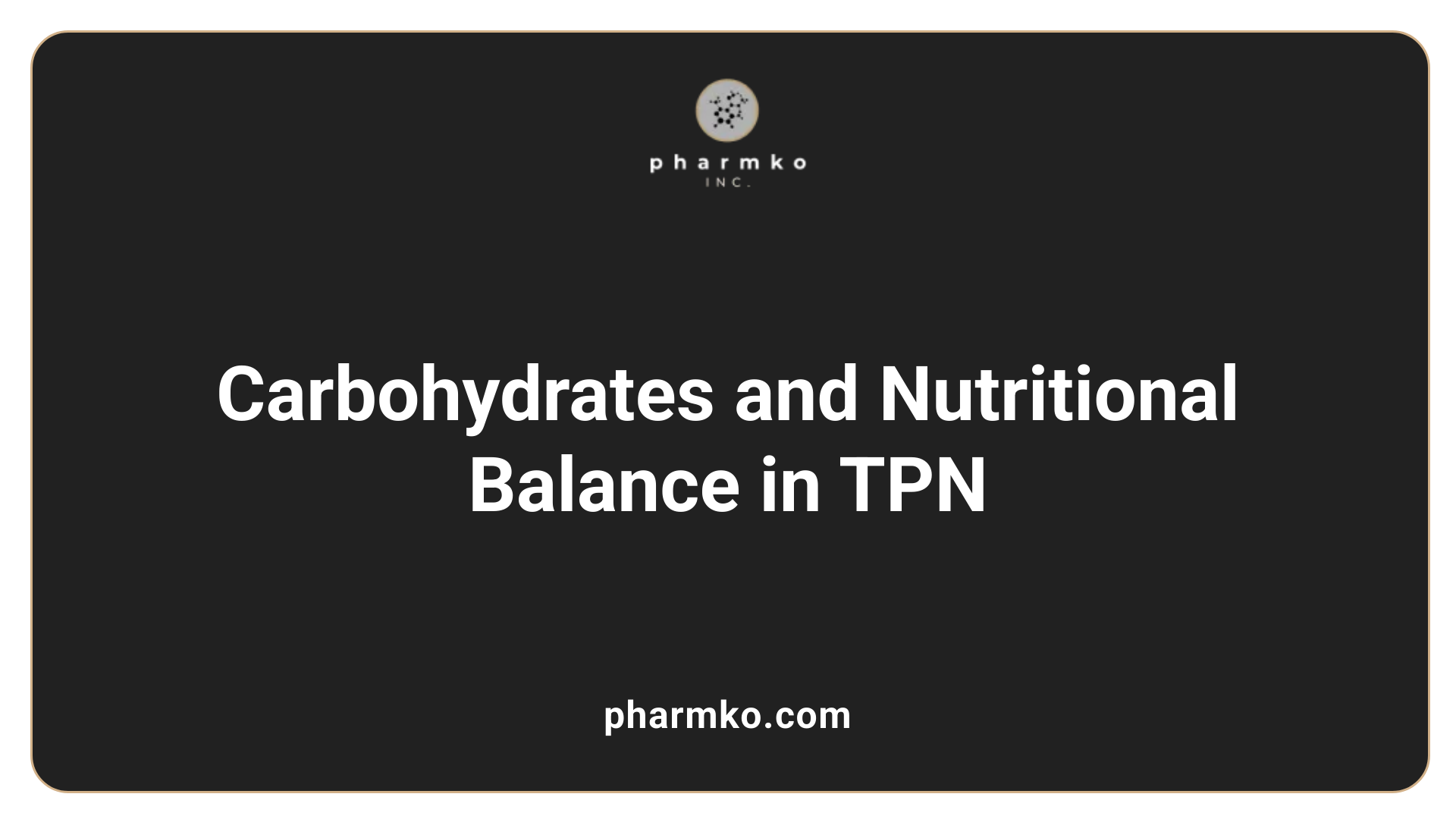
How do carbohydrates contribute to the nutritional balance and energy provision in TPN?
Carbohydrates are the primary source of non-protein calories in total parenteral nutrition (TPN), mainly supplied through dextrose solutions. They are vital for providing the necessary energy to support bodily functions, especially for vital organs like the brain, heart, and muscles. In TPN, approximately 60% of the total caloric intake typically comes from carbohydrates, with dextrose concentrations ranging from 5% to 70%. The standard infusion aims for about 3.0–3.5 grams per kilogram of body weight per day.
By delivering easily metabolized glucose, carbohydrates help prevent hypoglycemia, especially crucial when transitioning off TPN. They also work in tandem with amino acids and lipids to maintain a positive nitrogen balance, which is essential for tissue repair, immune function, and wound healing.
The infusion rate of glucose must be carefully regulated. It should not exceed the maximum oxidation rate of 4–7 mg/kg/min to avoid metabolic complications such as hyperglycemia, fat deposition in the liver (hepatic steatosis), and insulin resistance. Blood glucose levels are typically maintained within the range of 80–110 mg/dL, with at least a level below 145 mg/dL recommended to reduce the risk of morbidity.
In particular scenarios, such as in critically ill patients or those with diabetes or sepsis, initial carbohydrate infusion rates are reduced to 1–2 g/kg/day to prevent hyperglycemia. Close monitoring of blood glucose is crucial, and adjustments—including insulin therapy—may be necessary to manage elevated blood sugar levels.
Preventing hypoglycemia and supporting nitrogen balance
Carbohydrates in TPN are not only energy sources but also support nitrogen balance when combined with amino acids. This combination ensures efficient protein utilization and prevents catabolism. Adequate carbohydrate intake is crucial to avoid hypoglycemia during and after TPN therapy.
Supplying about 60% of non-protein energy as glucose helps meet this goal, especially when properly balanced with amino acids and lipids. This balanced approach promotes anabolic processes, tissue growth, and recovery.
Risks of excess and insufficient carbohydrate intake
While carbohydrates are essential, excessive intake can lead to adverse effects such as hyperglycemia, hypertriglyceridemia, hepatic steatosis, and insulin resistance. High glucose loads can overwhelm the body's metabolic capacity, especially in patients with pre-existing conditions like diabetes.
Conversely, insufficient carbohydrate provision elevates the risk of hypoglycemia, which can impair organ function and delay recovery. Therefore, tailoring the carbohydrate infusion rate to individual patient needs, clinical condition, and metabolic capacity is critical.
In summary, carbohydrates contribute significantly to the nutritional and energy needs during TPN. Proper management ensures metabolic stability, prevents complications, and supports the overall recovery process.
Clinical Guidelines and Safety regarding Carbohydrate Use

What are the clinical considerations and guidelines for including carbohydrates in TPN, particularly regarding safety and stability?
In total parenteral nutrition (TPN), carbohydrates play a vital role as the primary energy source, mainly supplied through glucose (dextrose). It is standard practice to provide about 60% of non-protein calories from glucose, typically ranging from 3.0 to 3.5 grams per kilogram of body weight per day. The glucose component in TPN solutions must be carefully balanced, considering the individual patient’s clinical status, metabolic needs, and risk factors.
Glucose is usually infused alongside amino acids and lipid emulsions to improve nitrogen balance and overall energy utilization. The recommended glucose concentration in TPN solutions can vary but generally stays within the 5% to 70% range; however, concentrations up to 60% are common. The stability of carbohydrate solutions within TPN depends on several physicochemical factors, including pH, osmolarity, and interactions with other nutrients, especially lipids. Maintaining proper formulation conditions and storing solutions under suitable conditions prolongs stability and safety.
Blood glucose monitoring is crucial during TPN therapy. Keeping blood glucose levels between 80 and 110 mg/dL reduces the risk of hyperglycemia, which can significantly increase morbidity and mortality. If blood glucose exceeds 145 mg/dL, measures such as insulin administration or reducing carbohydrate infusion rates become necessary. Patients at higher risk of hyperglycemia, such as those with diabetes, sepsis, or critically ill status, should start with a lower initial carbohydrate infusion rate of approximately 1–2 g/kg/day.
The maximum rate at which glucose should be infused is around 4-7 mg/kg/min, approximately 6-7 g per minute, to prevent complications like hyperglycemia, fatty liver, or respiratory issues. Infusion rates exceeding this limit may lead to metabolic disturbances.
Ensuring the stability and compatibility of carbohydrate solutions involves avoiding non-recommended sugars such as xylitol or fructose, which can cause adverse reactions or interfere with solution stability. Proper mixing, aseptic preparation, and cautious storage practices are essential to maintain solution integrity. Additionally, adjustments to carbohydrate dosing should be made based on ongoing clinical evaluation and laboratory assessments.
Overall, the inclusion of carbohydrates in TPN must be carefully managed to maximize nutritional benefits while minimizing potential metabolic and stability risks. Continual monitoring and individualized adjustment of TPN components are critical elements to ensure safe and effective nutritional support.
Impact of Carbohydrate Content on Blood Glucose and Hyperglycemia Management
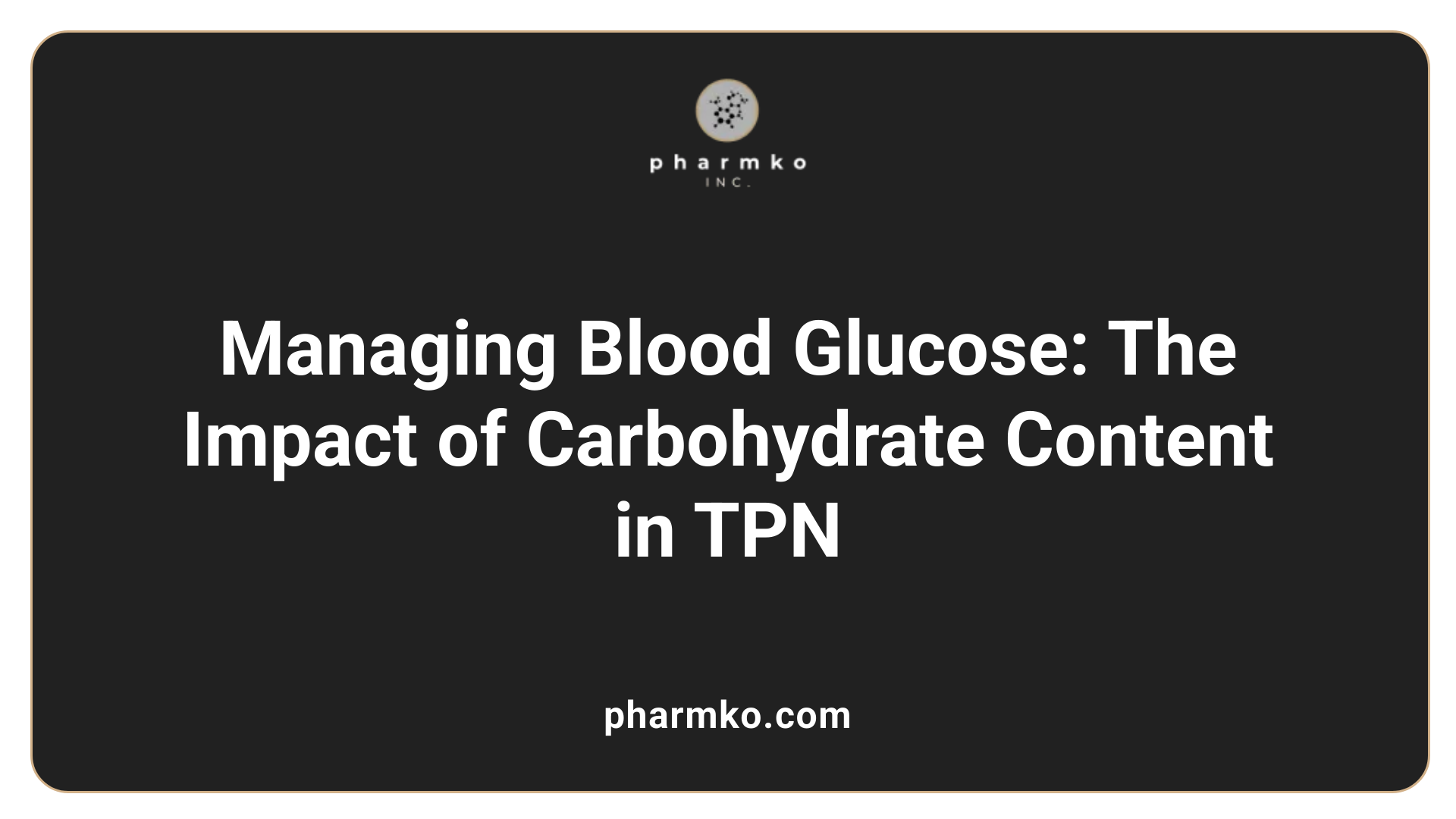
How does carbohydrate content impact blood glucose levels and what are best practices for managing hyperglycemia in TPN patients?
Carbohydrate intake is a vital determinant of blood glucose levels, especially in patients receiving total parenteral nutrition (TPN). The primary carbohydrate source in TPN solutions is dextrose, which can range in concentration from 5% to 70%, but typically up to 60% of total energy provision. When carbohydrate infusion exceeds the body's capacity to utilize glucose efficiently, it can lead to elevated blood glucose levels, known as hyperglycemia.
Excessive carbohydrate delivery can cause various adverse outcomes, including increased risk of infections, delayed wound healing, longer hospital stays, and higher mortality rates. Recognizing these risks underscores the importance of precise carbohydrate management in TPN formulas.
Best practices involve tailoring carbohydrate infusion rates to each patient's individual needs, considering factors such as age, metabolic status, and underlying conditions like diabetes or sepsis. The recommended initial carbohydrate infusion rate often starts below 5 mg/kg/min to prevent complications, especially in high-risk patients.
Monitoring blood glucose levels is essential. Blood glucose should be maintained within a target range of 80–110 mg/dL, with a limit of under 145 mg/dL to reduce morbidity and mortality. Frequent blood glucose measurements allow prompt detection of hyperglycemia.
In cases where hyperglycemia develops, strategies include reducing the carbohydrate component of TPN, employing insulin therapy, or a combination of both. Insulin therapy can be administered via continuous intravenous infusions for rapid adjustment or added directly to TPN bags in stable patients. Subcutaneous basal-bolus insulin regimens are suitable for stable patients with predictable needs.
The use of insulin as part of TPN management effectively controls blood glucose levels, minimizes complications, and improves overall outcomes. Combining nutritional adjustments—such as lowering dextrose concentration—and vigilant monitoring guides optimal therapy.
Strategies to prevent and manage hyperglycemia
Managing hyperglycemia during TPN involves a multifaceted approach:
- Optimizing carbohydrate infusion rate : Starting with conservative dextrose doses and titrating upward based on metabolic response.
- Monitoring blood glucose frequently : At least every 4–6 hours initially, then adjust as needed.
- Adjusting insulin therapy : Using continuous IV insulin infusions in unstable patients, with regular dose adjustments based on glucose measurements.
- Adjusting TPN composition : Reducing dextrose concentration or total carbohydrate content if persistent hyperglycemia occurs.
- Implementing nutritional protocols : Including early assessment of risk factors such as diabetes and sepsis.
These strategies collectively aim to maintain optimal blood glucose levels, reduce complications, and enhance patient recovery.
Use of insulin therapy and infusion adjustments
Insulin management during TPN is integral to controlling hyperglycemia. In critical or unstable patients, an intravenous insulin infusion provides rapid and precise control, adjusting doses based on frequent glucose measurements. This method allows for dynamic responses to fluctuations in blood sugar.
For stable patients, insulin can be added directly to TPN bags using pre-mixed insulin formulations, or administered via scheduled subcutaneous injections, suitable for maintaining consistent glycemic control.
Adjustments in insulin dosing depend on continuous glucose monitoring data, overall clinical status, and response to therapy. The goal is to keep blood glucose levels within the recommended target range, minimizing both hyperglycemia and hypoglycemia risks.
In conclusion, managing carbohydrate content and employing insulin therapy are vital in preventing and controlling hyperglycemia in TPN patients. Through careful monitoring and individualized treatment, healthcare providers can improve outcomes and reduce complications associated with TPN therapy.
Importance of Carbohydrate Regulation for Optimal Outcomes

Why is carbohydrate regulation important in TPN to optimize patient outcomes and prevent complications?
Carbohydrate regulation plays a crucial role in the safe and effective administration of total parenteral nutrition (TPN). Glucose, the primary carbohydrate used in TPN, provides the main source of energy necessary for cellular functions, especially in the brain and central nervous system. However, delivering too much glucose can exceed the body's capacity to metabolize it efficiently, leading to hyperglycemia.
When blood glucose levels rise excessively, patients face increased risks of complications such as infections, delayed wound healing, and higher morbidity and mortality rates. Hyperglycemia can impair immune function, promote bacterial growth, and interfere with tissue repair processes. Therefore, maintaining blood glucose within a normal range—generally 80–110 mg/dL—is vital.
In critically ill or diabetic patients, the risk of blood sugar dysregulation is even higher. These patients require careful adjustment of carbohydrate doses, often starting with a lower infusion rate of 1–2 g/kg body weight/day. Regular glucose monitoring helps detect early signs of hyperglycemia, enabling timely intervention such as insulin administration or modification of infusion rates.
Moreover, controlling carbohydrate intake promotes metabolic stability. Excess glucose can overwhelm insulin responses, resulting in fat deposition in the liver (hepatic steatosis) and respiratory issues due to increased carbon dioxide production. Hence, the maximum glucose oxidation rate should be maintained below 4–7 mg/kg/min to prevent these issues.
Balancing carbohydrates with other macronutrients, particularly amino acids and lipids, enhances nitrogen balance and overall metabolic efficiency. This approach supports tissue repair, immune function, and energy needs.
How does the customization of carbohydrate dosing impact patient recovery?
Personalizing carbohydrate doses based on individual needs—considering factors like age, weight, medical condition, and laboratory results—optimizes outcomes. For example, in patients at high risk of hyperglycemia, such as those with sepsis or on steroid therapy, starting with a conservative carbohydrate infusion of 1–2 g/kg/day allows the body to adapt and reduces the risk of metabolic disturbances.
Adjustments are made based on ongoing assessment of blood glucose, nutritional status, and metabolic responses. This dynamic management ensures that patients receive adequate calories without the adverse effects of hyperglycemia or other glucose-related complications.
In conclusion, meticulous regulation of carbohydrate delivery in TPN is fundamental to safeguarding patient health. It minimizes risks such as infections, delayed wound healing, and organ dysfunction, thereby improving overall recovery. Close monitoring and tailored dosing strategies are essential to achieving these goals and delivering safe, effective nutritional support.
Formulation and Physicochemical Considerations in Carbohydrate Inclusion

How are carbohydrates formulated and incorporated into TPN solutions?
Carbohydrates, mainly in the form of glucose, are a fundamental component of total parenteral nutrition (TPN) solutions, primarily serving as the main energy source. These carbohydrates are formulated by dissolving glucose, typically as dextrose monohydrate, into the TPN mixture. The concentration of glucose in solutions can vary widely, ranging from as low as 5% to as high as 70%. However, most TPN formulations aim to include glucose at levels that provide up to 60% of the total energy intake to meet the patient's caloric needs.
The amount of carbohydrate is carefully calculated based on individual patient requirements, often set at about 3.0–3.5 grams per kilogram of body weight per day. For patients at high risk of hyperglycemia—such as those who are critically ill, diabetic, or undergoing steroid therapy—a lower initial carbohydrate infusion rate of 1–2 g/kg/day is recommended to mitigate risks.
Excess carbohydrate intake can lead to metabolic complications like hyperglycemia and hypertriglyceridemia. Therefore, meticulous monitoring of blood glucose levels is essential. Maintaining blood glucose within a normal range (80–110 mg/dL, with less than 145 mg/dL) helps prevent morbidity and mortality.
In addition to individual patient needs, carbohydrate formulation should be done alongside amino acids and lipid emulsions. This combination helps optimize nitrogen balance and overall metabolic stability, essential for patient recovery and health.
Carbohydrates and TPN Stability, Compatibility, and Delivery

What role do carbohydrates play in the stability, compatibility, and delivery of TPN?
Carbohydrates, primarily supplied as dextrose, are fundamental components of Total Parenteral Nutrition (TPN). They serve as the main energy source, accounting for roughly 50-60% of total caloric intake in TPN formulations. Beyond their nutritional role, carbohydrates influence the physical and chemical stability of the TPN solution.
The concentration of glucose in the TPN mixture significantly impacts osmolarity, which in turn affects how the solution can be safely administered — typically through central venous access for hyperosmolar solutions. Maintaining optimal osmolarity is essential to prevent complications like thrombophlebitis.
Carbohydrates also have a pronounced effect on the physicochemical properties of TPN solutions. Elevated glucose levels can disrupt lipid emulsions by destabilizing the oil-water interface, risking phase separation and reducing the safety and efficacy of the formulation. Moreover, glucose's reducing properties can promote Maillard reactions, which may alter the bioavailability of amino acids and other nutrients, potentially creating toxic reaction products if not carefully managed.
The pH of the TPN solution is also affected by carbohydrate content. Since glucose influences the acidity of the solution, it can impact the stability of delicate components such as calcium-phosphate salts, which are vital for bone health. Incorrect pH levels can cause precipitation or solubilization issues, risking emboli or compromised nutrient delivery.
Storage conditions, including temperature and exposure to light, further influence carbohydrate stability. Higher temperatures can accelerate degradation processes, while light exposure might promote unwanted chemical reactions, both of which may compromise the safety, stability, and shelf life of TPN solutions.
Interactions between glucose and other nutrients are critical. For example, high glucose concentrations can lead to incompatibilities with minerals and proteins, affecting their bioavailability and overall nutritional effectiveness. Therefore, formulators must carefully balance carbohydrate levels to optimize nutrient stability and ensure compatibility with other TPN components.
In summary, carbohydrates are indispensable for energy provision in TPN but require meticulous control over concentration, pH, storage conditions, and their interactions with other nutrients. Proper formulation and handling are crucial to maintain the stability, compatibility, and safe delivery of TPN, ultimately supporting optimal patient outcomes.
| Aspect | Impact | Considerations |
|---|---|---|
| Osmolarity | Affects IV safety | Keep within safe limits; central vs. peripheral access |
| Lipid stability | Risk of emulsification failure | Monitor glucose levels; control pH |
| Maillard reactions | Nutrient bioavailability | Avoid excessive heat and uncontrolled pH |
| Storage conditions | Degradation risks | Store at appropriate temperatures, protect from light |
| Nutrient interactions | Compatibility issues | Balance concentrations; monitor lab results |
Understanding these interactions and the physicochemical challenges associated with carbohydrate use in TPN formulations is essential for clinicians and pharmacists to optimize therapy and minimize risks.
Scientific and Medical Understanding of Carbohydrates’ Function in Parenteral Nutrition
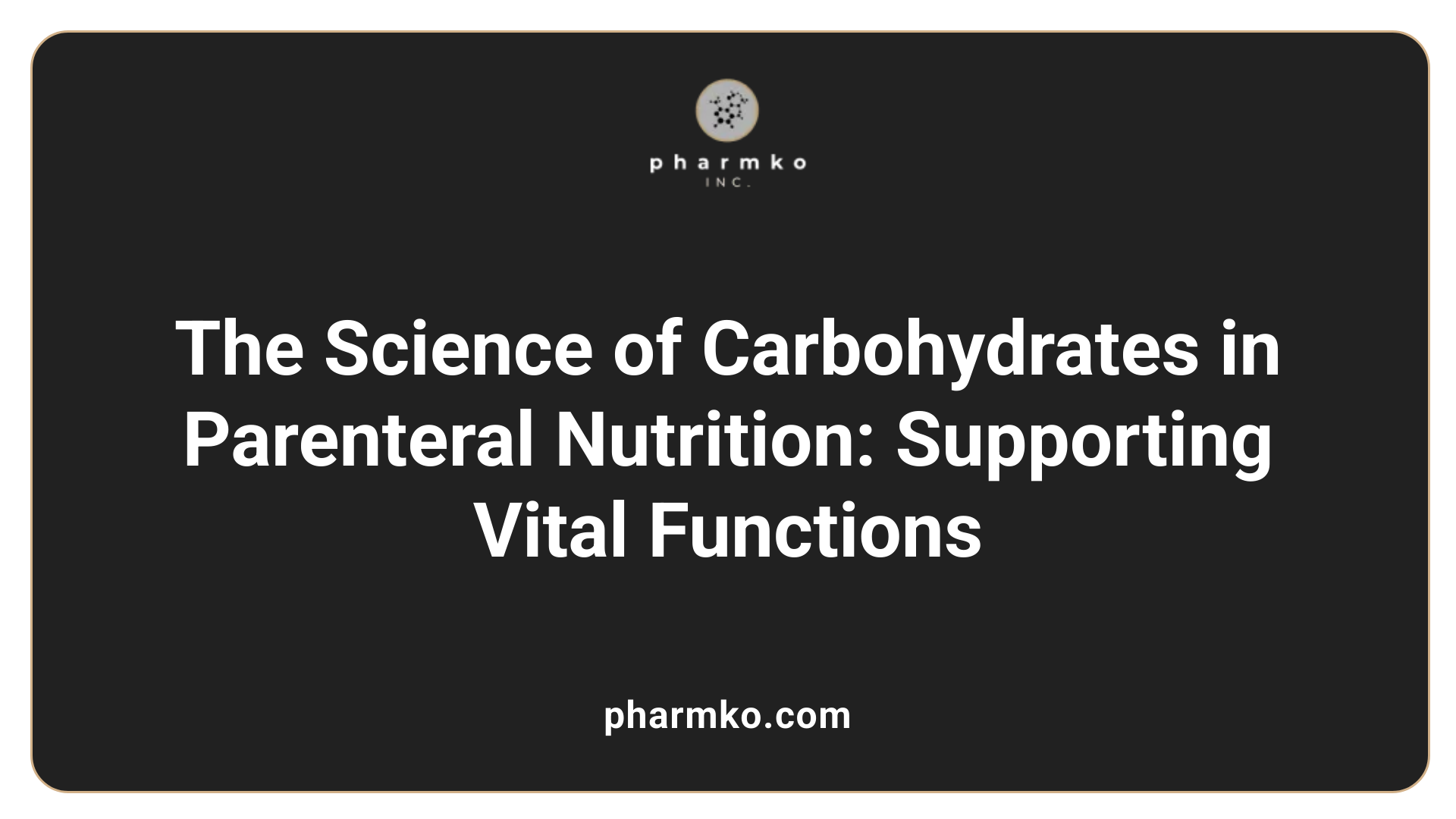
What is the scientific and medical understanding of carbohydrates’ functions within parenteral nutrition?
Carbohydrates are an essential component of parenteral nutrition (PN), primarily serving as the main energy source for patients. In clinical practice, dextrose solutions are used extensively because they are safe, well-tolerated, and efficiently metabolized by the body. These solutions generally provide about 50-60% of daily caloric requirements, aligning with nutritional guidelines.
The most common carbohydrate form in PN is dextrose monohydrate, available in concentrations of 5%, 10%, 20%, up to 70%. Standard practice often involves providing 3.0–3.5 grams of dextrose per kilogram of body weight daily to meet energy demands without overwhelming the body's capacity to utilize glucose. This balance is vital because excessive carbohydrate infusion can lead to complications such as hyperglycemia and hypertriglyceridemia.
Glucose’s primary role within PN extends beyond simple energy provision. It plays a crucial part in supporting metabolic functions, including maintaining blood glucose levels within safe limits and supporting overall nitrogen balance, especially when combined with amino acids and lipids. These mixture components work synergistically to promote effective nutrient utilization and prevent catabolism.
Scientific understanding emphasizes that glucose should not surpass the maximum oxidation rate of 4-7 mg/kg/min to avoid metabolic derangements. Continuous monitoring of blood glucose levels is fundamental, especially in critically ill patients, diabetics, or those with sepsis. When hyperglycemia occurs—defined as blood glucose levels above 180 mg/dL—appropriate measures such as insulin therapy or reduction of carbohydrate infusion are necessary.
In addition to providing energy, carbohydrates influence various physiological processes, including supporting central nervous system (CNS) function. The brain relies heavily on glucose as its primary energy source. Therefore, maintaining adequate glucose levels is essential for cognitive function and neural activity.
Interaction with other nutrients is critical in the design of PN formulations. Carbohydrates are infused together with amino acids and lipid emulsions. This combination improves nitrogen balance and overall metabolic stability, enabling patients to meet their nutritional needs without disrupting physiological homeostasis.
In summary, the scientific and medical perspective on carbohydrates in PN underscores their fundamental role in energy provision, metabolic regulation, CNS support, and interaction with other nutrients to achieve safe and effective nutritional therapy.
Summary and Future Perspectives on Carbohydrate Use in TPN
Understanding the integral role of carbohydrates in TPN formulation underscores the importance of precise planning, formulation, and monitoring. Glucose remains the cornerstone carbohydrate, vital for energy and supporting critical physiological functions. Advances in formulation technology, along with vigilant clinical management, continue to enhance the safety, stability, and efficacy of TPN solutions. Future research focusing on metabolic responses, individualized dosing, and novel carbohydrate sources promises to further optimize parenteral nutrition, minimizing complications such as hyperglycemia and promoting better patient outcomes.
References
- Total Parenteral Nutrition - StatPearls
- Carbohydrates – Guidelines on Parenteral Nutrition ...
- Parenteral Nutrition Formulation
- Parenteral Nutrition: What it Is, Uses & Types
- The Hitchhiker's Guide to Parenteral Nutrition Management ...
- 8.8 Total Parenteral Nutrition (TPN)
- Stability and compatibility of parenteral nutrition solutions



